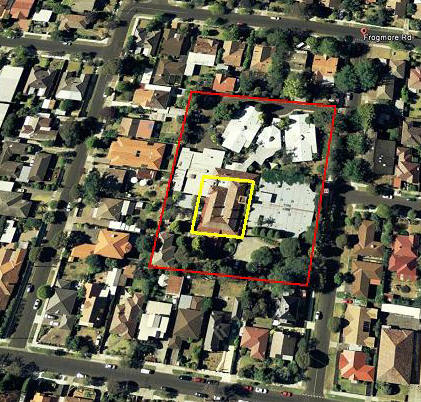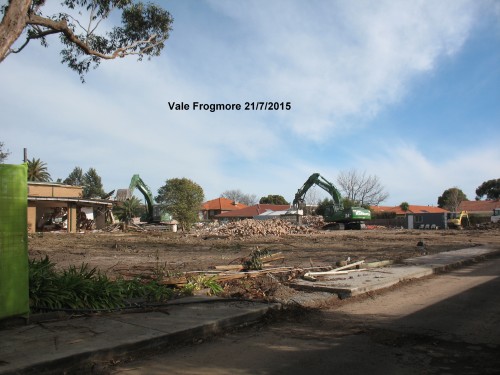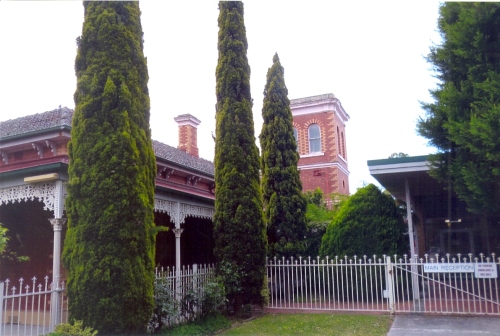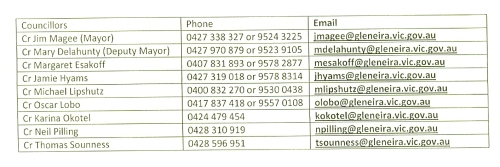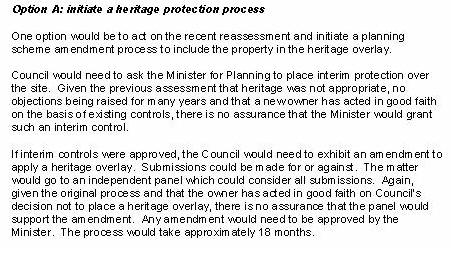
The third* part of the residents’ campaign to save Frogmore occurred in early May (6/5/2015) and comprised a Planning Conference related to Council’s Planning Scheme Amendment C137 to apply an Heritage Overlay to 1 Wahgoo Road, Carnegie. Those attending (25+) the planning conference included residents, a representative from the National Trust, the property owner (Churches of Christ – Queensland) and the potential purchaser (Jewish Care). In addition to those attending Council advised receipt of 303 letters supporting the Heritage Overlay and 2 letters opposing Heritage Overlay.
* Refer to GERA’s earlier postings – Save Frogmore, Save Frogmore – Part 2
While Council’s objective of a planning conference is not to make a decision but rather to provide “a public and open forum where discussion of the proposal can occur between the parties with a view to identifying affected resident concerns, possible means for addressing the concerns and opportunities to improve the proposal” , the attending residents did not believe that objective had been achieved. The residents believed the 8,000 sqm site presented a unique opportunity for a redevelopment proposal that could both preserve Frogmore’s heritage significance (as identified and recommended by Council’s Independent Heritage Advisor) and accommodate an Aged Care Facility (albeit a scaled back facility). However, the potential purchaser* (Jewish Care) expressed the view that optimum redevelopment of the site for an Aged Care Facility did not allow for the retention of Frogmore and gave little consideration to a less than optimum redevelopment. As a result of this inability to reach common ground residents hold grave concerns for the retention of Frogmore – Council is to discuss the planning conference outcome and decide whether to continue or abandon Amendment C137 at next Tuesday’s Council Meeting (9/6/2015).
* Please note that at the Planning Conference both the potential vendor (Churches of Christ, Qld) and the potential purchaser (Jewish Care) stated that ownership of the property has not changed hands and that the sale remains, as stated in the October, 2014, media releases, a conditional sales agreement dependent upon planning approval.
BACKGROUND
Before outlining the planning conference discussion, the following is a brief summary GERA’s 2 previous posting’s and Council’s independent heritage advisors report. This will make for a longer than average post but should draw our previous postings together.
Save Frogmore Timeline
October, 2014 – Churches of Christ (Qld) and Jewish Care announce conditional sale and proposed redevelopment of site (1 Wahgoo Road, Carnegie). The sale was (and still is) conditional upon obtaining planning approval.
16/12/2014 – Residents lodge petition (1,000+ signatures) requesting heritage recognition for Frogmore. Council passes motion for an independent heritage assessment to be undertaken.
January, 2015 – Council obtains an Interim Protection Order on Frogmore to prevent demolition prior to Council formalising the decision to protect, or not to protect, Frogmore.
3/2/2015 – Independent Heritage Advisor’s (Graeme Butler) report which recommended Municipal Heritage Protection, together with a highly questionable unnamed Officer’s Report, submitted to Council. Council voted 6 to 3 (For – Sounness, Okotel, Lobo, Delahunty, Esakoff and Magee; Against – Pilling, Hyams and Lipshutz) to apply Heritage Protection at the Local Level as recommended by the Heritage Advisor and in accordance with Clause 21.10 of the Local Planning Policy Framework.
13/3/2015 – As a result of Save Frogmore Campaigners’ submissions requesting State Level Heritage Protection, Heritage Victoria published its assessment and did not recommend State Level Heritage Protection (Heritage Victoria Assessment) . This assessment, and petitioners’ subsequent submissions, to be reviewed by Heritage Council early June, 2015.
6/5/2015 – Planning Conference of Amendment C137 Heritage Overlay on Frogmore.
9/6/2015 – Council decision to abandon or continue applying the Heritage Overlay.
Council’s Independent Heritage Advisors Report – February, 2015
Before summarising the above report, readers should note the report disagrees with the construction date of Frogmore House. The Save Frogmore campaigners believe the surviving house was constructed in 1857 (which would enhance Frogmore’s heritage significance via association with renowned architect Joseph Reed and the original owner – pioneering pastoralist William Lyall) whereas the advisor’s report gives a construction date as 1889 (which excludes the Reed/Lyall associations but retains the association with pastoralist Archibald McLauren (second owner) and subsequent owners while also attributing architectural design to noted architect Sydney W. Smith).
It is understood that the campaigners have lodged submissions to the Victorian Heritage Council providing further support of the 1857 construction date. Pending the Heritage Council determination of the subsequent submissions, for the purposes of this posting GERA accepts the Independent Heritage Advisor’s 1889 construction ’s date
Frogmore’s Heritage Significance
Recommendation
“Frogmore House is significant to the City of Glen Eira historically and aesthetically … and should be conserved as one of the cultural assets of the city.
Frogmore house should be included in the schedule to the heritage overlay clause 43.01 in the Glen Eira Planning Scheme.”
Why is Frogmore House significant
Briefly the Independent Heritage Advisors Report found that Frogmore was Locally significant to Glen Eira on the following basis
- Historically – demonstrates pattern of settlement and growth of the Municipality development
- Rarity – As a former farm residence, Frogmore is rare within Glen Eira
- Aesthetically – Architectural design and features
- By Association – with designing architect and the achievements, cultural and spiritual associations of owners.
Additional details of the Advisor’s significance findings are available in
- a summarised version as a footnote to this posting or
- the Independent Heritage Advisor Report , available on Council’s website (C137_Graeme_Bulter_Heritage_Assessment_Report)
PLANNING CONFERENCE DISCUSSION
Residents
All residents voiced the opinion that good planning resulted in planning outcomes that enabled both heritage retention and sympathetic redevelopment of large sites – on such sites, good design should enable heritage retention without preventing redevelopment and redevelopment without the loss of recognised heritage assets. In this instance, and in line with Glen Eira’s Community plan, both heritage preservation and the provision of Aged Care Facilities were seen as compatible uses that respond to the community’s needs.
- The size of the property is capable of accommodating both an Aged Care Facility and the retention of Frogmore House and its significant vegetation. (Site size 8,000 sqm, house size 718 sqm, estimated vegetation area 300 sqm)
- Frogmore House is the only surviving, recognised heritage building within the Carnegie/Murrumbeena area. As more and more quality period homes are lost forever to more intensive development Frogmore’s heritage value increases.
- While Frogmore has “slipped through the cracks” in past heritage reviews, the Independent Heritage Report now imposes a duty on Council to recognise Frogmore’s significance by preserving it for current and future residents.
- The significance of heritage to fostering the development of a community and a sense of identity is both well documented and widely acknowledged.
- The condition of the building is good. Both Council’s Heritage Advisor’s Report and Heritage Victoria’s assessment states that
- The original features of the house remain largely intact
- Except for one, all building alterations (i.e. newer building annexes which are excluded in the proposed heritage overlay) have been largely superficial.
In addition, the buildings continued usage as an aged care facility until December, 2014 (when the Betheden Aged Care Facility was closed) also indicates that Frogmore’s structural condition is sound and internally is well maintained.
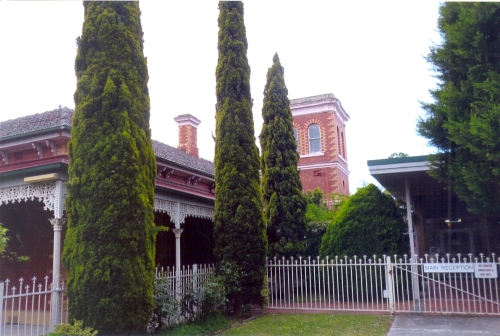

Residents also voiced their criticism of the unnamed Officers Report submitted to Council 3/2/2015. These criticisms were
- the inclusion of inappropriate comments referring to the Council’s 1996-2003 Heritage Assessment (eg. that “the time to speak up was then not now”) which
- does not reflect the “representative” nature of local government nor does it show that Council is responsive to the social and demographic changes that have occurred since 2003, and
- contradicts the report’s subsequent comment that, “any party, notwithstanding the 1996-2003 assessment, has the ability to request/justify the addition of a property to the Glen Eira heritage register”.
- The report’s omission of significant vegetation included in the Heritage Advisor’s Report – 2 Canary Palms and Silky Oak
- The Report’s reference to the 1996 – 2003 Heritage Assessment which
- while recognising Frogmore’s significance gave it a Grade C category which excluded it from inclusion in a heritage overlay because it was not located “within an identified heritage area” – arguably (then and now) Frogmore’s stand-alone location rather than detracting from its heritage significance, actually enhances that significance.
- This much earlier heritage assessment did not include associations that were included in the 2015 assessment and arguably it should have.
- The report, written after receipt of the heritage advisor’s report, was weighted to full site redevelopment rather than focusing on the key issue of heritage. The report does not refer to Council’s heritage strategies which are to
- Protect places identified as having architectural, cultural or historical significance.
- Ensure sympathetic redevelopment and renovation of areas and places identified as having architectural, cultural or historic significance in the municipality.
- Enhance knowledge and popular understanding of Glen Eira’s architectural, cultural and historic heritage.
- The report omitted to mention that the Planning Scheme encourages Aged Care Facility to be located in the various centres that have been designated for high density development rather than in the Neighbourhood Residential Zone (which is the zone applicable to the site). The reasons being that
- Aged Care Facilities tend to increase in size and can become disruptive (visitor and servicing vehicle volumes and increased parking demand) in Residential Areas
- Provides proximity to various facilities (shops, services, public transport) that enhances the aged care residents’ independence.
Please also note that,
- contrary to the officer’s report stating that the property had been sold, at the Planning Conference both the Churches of Christ (Qld) and Jewish Care stated that property has not been sold and the sale remains conditional pending planning approval.
- That the property’s location does not provide facility residents with convenient access to local shopping or service centres. Facility residents will need to access these centres by either private vehicle or the Murrumbeena Road bus service.
Potential Vendor (Churches of Christ, Qld)
- The Churches of Christ (QLD) representative stated that since 1951 Frogmore House has been associated with the provision of residential aged care. (Originally a 25 bed facility, successive expansions had seen it grow to 60 beds at the time of closure)
- The decision to close the facility was the result of legislative changes (related to residential aged care accommodation standards) that, in their view, made redesign of the facility impractical and the sale of the property (with resulting funds being available for other charitable operations) the more attractive alternative.
Potential Purchaser (Jewish Care)
- Had been seeking potential sites to provide their community with aged care facilities for a period of time and had the selected the site because of its size and proximity to services and facilities. Sites of this large size were not readily available in Glen Eira and the Planning Scheme’s continuous use* clause would enable the construction and operation of an Aged Care Facility in a Neighbourhood Residential Zone.
* The concept of continuous use (also known as existing use) provides for a previously legal or permitted use to continue even though subsequent changes to the planning scheme may now prohibit that use.
Please note that residents objection to the proposed redevelopment focused a scaling back of proposal that would accommodate both heritage preservation and aged care facility use. No resident objected to continuous use of the site.
- In assessing a site’s potential, the proposed purchaser used modelling tools (comprising many diverse factors, including Legislative requirements and Planning Scheme constraints) for either a 60 or 120 bed facility. If the total site was redeveloped the site could accommodate the 120 bed model, however, if Frogmore was to be retained, the location of the house on the lot would constrain the redevelopment to a 60 bed facility. While the potential purchaser appreciated heritage, in their view, building a 120 bed facility represented a Net Community Benefit (NCB) of 60 beds which outweighed Frogmore’s heritage value. Based on this analysis, the potential purchaser was reluctant to consider a smaller facility for the site and would prefer to seek alternate sites.
Residents pointed out that
- It is up to the Glen Eira Community and due Planning Processes (which provides for community input) to determine what constitutes Net Community Benefit.
- That the arithmetic equation (ie which is based solely on the difference of what could be built if Frogmore is not retained vs. what could be built if Frogmore is retained – NCB = 120 – 60) is simplistic and assigns a zero value to heritage preservation. This is contrary to well established planning principles that recognise and value heritage retention – such a valuation should be undertaken by accredited professionals and the results may outweigh the NCB value of 60 beds. In addition, little evidence or justification was provided to support use of only two models.
- The National Trust Representative offered the Trusts assistance with the proposed redevelopment’s planning and heritage issues. Although this offer was not responded to at the Planning Conference, follow-up is anticipated to occur.
- Presumably in support of the zero heritage value, the potential purchaser commented that Victoria Heritage had not recommended State Level Heritage Protection for Frogmore.
Residents outlined the 3 levels of Heritage Protection that exist within Australia. These being National, State and Local – with each heritage assessment application being assessed using similar criteria with, because of the extent of the areas being reviewed, varying standards are applied to each criteria. At the Local level, Council commissioned an Independent Heritage Advisor’s Report which unequivocally recognised the significance of Frogmore and also unequivocally recommended a Heritage Overlay be applied to Frogmore.
- The potential purchaser indicated that considerable costs had been incurred in both the property search and in preparation of plans. The plans were nearing completion and would shortly be lodged with Council.
Please note that, as is customary, these plans have not be publicly discussed with, or shown to residents. Residents knowledge of the plans is limited to the information included in the previously mentioned press releases and the planning conference discussion.
THE NEXT STEP
As previously mentioned the next step in the Heritage Overlay process is for Council to decide, on 9/6/2015, to continue or abandon the Planning Scheme Amendment process. While many residents have expressed concern re the outcome of the Planning Conference and that Council may decide to abandon the process based on the above Net Community Benefit calculation, GERA trusts that Council will proceed with the process of implementing the amendment. This will ensure
- Due planning processes are followed to ensure that residents are able to participate in those processes which would include input into the determination of Net Community Benefit and a quantifiable Heritage Valuation by an accredited professional.
- Due consideration is given to Council’s Independent Heritage Advisor’s Assessment , which deemed Frogmore as meeting the threshold for inclusion in the local heritage overlay under Clause 21.10 of the Local Planning Policy Framework – a framework which Council has a responsibility to uphold.
- Consistency with Council’s Heritage Strategies of
- Protecting places identified as having architectural, cultural or historical significance.
- Ensuring sympathetic redevelopment and renovation of areas and places identified as having architectural, cultural or historic significance in the municipality.
- Enhancing knowledge and popular understanding of Glen Eira’s architectural, cultural and historic heritage.
- Consistency with the objectives of planning for Victoria (as identified in the Planning and Environment Act 1987) in that continuing the amendment process will:
- Provide for the fair, orderly, economic and sustainable use, and the development of land;
- Secure a pleasant, efficient and safe working, living and recreational environment for all Victorians and visitors to Victoria;
- Conserve and enhance those building, areas or other places which are of scientific, aesthetic, architectural or historical interest, or otherwise of special cultural value; and
- Balance the present and future interests of all Victorians.
- Frogmore is preserved, at least until due planning processes have occurred.
************
Footnotes:
THE NEXT STEP
Readers should note that continuing with the potentially lengthy, planning scheme amendment process will involve.
An Independent Planning Panel hearing and assessment/recommendation
A Council decision on to accept or reject the Independent Planning Panel’s recommendations
SUMMARISED INDEPENDENT HERITAGE ADVISOR’S FINDINGS
Why is Frogmore House significant
- Historically
- Early associations with stock breeding and farming and the early pattern of land settlement
- 1880’s redevelopment linked to key early development with the City and the late Victorian-era land boom. This link makes it part of the Glen Eira Victorian era architectural heritage
- ArchibaldMcLauren association
- Noted pastoralist in two colonies
- Subdivision allowed for growth of Caulfield District and Gippsland Railway opening
- Early Caulfield District Roads Board Member, Councillor and philanthropist
- Frogmore House designed by Sydney W. Smith (son of architect Sydney William Smith who designed Caulfield Town Hall) early in his long and distinguished career.
- Rarity
- Frogmore is now rare within the Glen Eira because of the combination of age, scale, architectural style and historical associations.
- Few identified Victorian era Italianate villas have survived in Glen Eira with none identified in the Carnegie/Murrumbeena area (which was relatively unaffected by the Victorian era building boom).
- Glen Eira’s surviving Victorian-era residential building stock were residences of professional Melbourne City workers and are not associated with working farms.
- No other known example of Sydney W. Smith’s 1880’s work directly parallels the design. Of the buildings designed by the Smith’s, only the Caulfield Town Hall (father) and Frogmore House (son) survive in Glen Eira.
- Aesthetically
- Architecturally designed Frogmore House is a good example of a Victoria-era Italianate villa. It was and is rare in the Carnegie/Murrumbeena area
- Frogmore House features include
- Diachromatic brickwork
- Diachromatic tower that has become a landmark
- Verandahs on three sides
- By Association
- Early associations, via crown land sales, with William Lyall and his model farm.
- House and Land associations with Archibald McLauren, the dominance of pastoral activities in the Victorian era and the later growth of the Caulfield District via land subdivision and immigration.
- The cultural and spiritual associations held by subsequent owner/occupiers (Gairdner, Seelemeyer, Menck, Keys, Churches of Christ).


